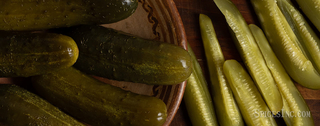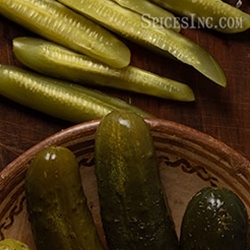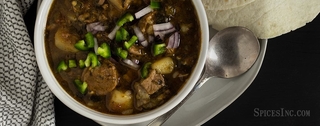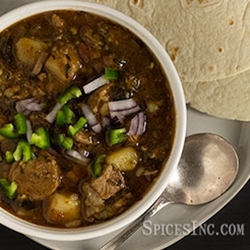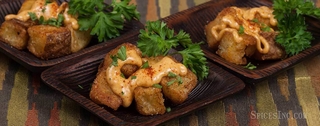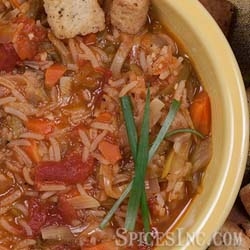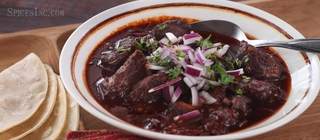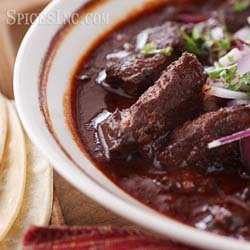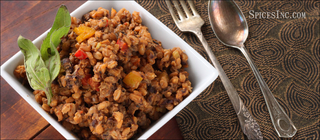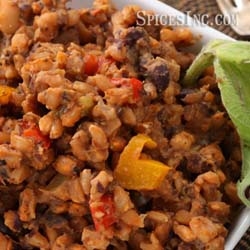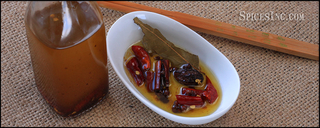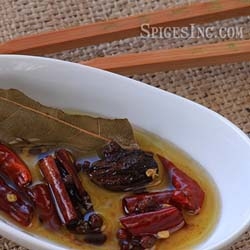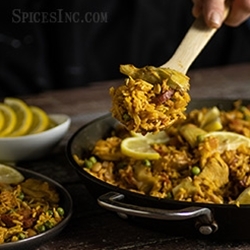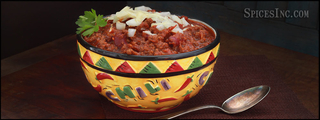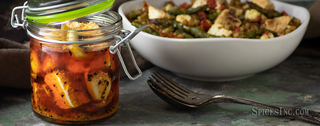Organic Bay Leaves
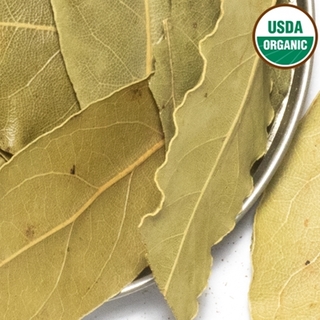

Organic Bay Leaves
Organic Bay Leaves, Laurus nobilis, are also called organic bay leaf.
Bay Leaves have an essential oil of .8% - 3.0%.
There are approximately 132 bay leaves per ounce.
What Are Organic Bay Leaves
These certified Organic Bay Leaves are typically used to season long-cooking dishes like braises, soups, and stews, but can also be added to quicker-cooking dishes such as pasta sauces or rice. Organic Bay Leaves can be used whole or crumbled before adding during the cooking process.
Dried bay leaves have a more pleasant, sweeter taste than fresh and the flavor becomes more intense the longer it cooks. We've looked at numerous bay leaf suppliers and found our current supplier's Organic Bay Leaves to be far superior, not only in color and flavor, but in having more whole leaves.
These Organic Bay Leaves are considered true Bay Leaves and should not be confused with California Bay Leaves, Umbellularia californica, which come from a different plant entirely and while their leaves have a similar flavor to true Bay Leaves, they are even more pungent. In the book Mastering the Art of French Cooking, Julia Child wrote “American bay is stronger and a bit different in taste than European bay. We suggest you buy imported bay leaves.” We are not one to argue with the wisdom of Julia Child. Today imported Organic Bay Leaves do not actually come from Europe but from either India or from the Mediterranean coastal region of Turkey.
The tree that produces Bay Leaves is called either a bay tree or a laurel tree.
History of Bay Leaves
The origin of Bay Leaves is most probably South Asia, from where it spread to the Asia Minor region of the Middle East. The tree was discovered by the Ancient Greeks over 3,000 years ago in what is modern day Turkey and was brought back to Greece and Rome for cultivation.
The ancient Greeks decorated their statues of Aesculapius (God of medicine) with laurel leaves. Triumphant athletes of ancient Greece were awarded laurel garlands and these were given to winners at Olympic games beginning in 776 BC. It was also believed that the laurel provided safety from Zeus, the Greek God of weather who was responsible for hurling lightning bolts and causing thunder. The second Roman Emperor Tiberius (42 BC - 37 AD) always wore a laurel wreath for protection during thunderstorms.
By the Middle Ages (500 - 1500 AD), the leaves popularity spread throughout Europe for both medicinal and culinary use and they were cultivated in Medieval monasteries. Their rich, gentle, savory flavors paired easily with popular roast meats and the evolution of stocks and sauces that were rapidly developing in Medieval and Renaissance kitchens. Guillaume Tirel, known as Taillevent, who was one of the first truly "professional" master chefs as well as the chef to France's King Phillip VI (beginning in 1326), listed Bay Leaf among the basic spices in his kitchen cupboard.
Just as many New World foodstuffs crossed the Atlantic aboard Spanish galleons and were introduced to Europe, so too were European ingredients brought to the Americas. Bay Leaves were one of the herbs exported into Mexico and the early America.
Bay Leaf Cultivation
Bay Leaves are an aromatic evergreen tree or large shrub in the family Lauraceae, cultivated for their leaves. Native to South Asia and Asia Minor, Most of the last remaining pockets of laurel forests in the Mediterranean are found in the mountains of southern Turkey, northern Syria, southern Spain, north-central Portugal, and northern Morocco.
Bay Trees thrive in more humid environments and are found growing at the edge of streams, places where the base water is high, or at altitudes open to the humid winds of the sea. Bay Trees can also be found on the region’s arid southern slopes, where there is no seepage water or moist stream environment but is open to humid sea breezes. Does best with annual rainfall of between 25 - 80 inches. Ideal soil is sandy loam or clay loam. Bay trees prefer temperate winters (where temperatures rarely drop below 50°F).
While bay trees can reach a height of up to 60 feet in a natural environment, in a commercial setting they are kept at the shrub height of 4-6 feet tall. At harvest time the tree should be reduced to 8" from the collar which results in a repeated harvest cycle. Commercial harvesting begins in the 4th or 5th year after the initial seedling planting and the crop reaches full capacity in the seventh to eight year. Bay leaves are generally picked from mid November until the beginning of March. The leaves are dried in sheds and turned every 3-4 days. The leaves take 10-15 days to fully dry. Once dry the leaves are removed from the branches and placed in air-tight sacks for transportation.
Where Are Our Organic Bay Leaves From
Depending on the time of year and availability these may come from India or Turkey.
Is It Better to Use Fresh or Dried Bay Leaves
Some herbs are better when used fresh (ie basil, cilantro, and parsley) while others are more flavorful when dried (ie curry leaves, oregano, marjoram, rosemary, and thyme). We fall into the camp that Dried Bay Leaves are better than fresh. For herbs that are better dried than in their fresh state this has to do with their volatile oils. The drying process concentrates their volatile oils making them more flavorful.
The other thing to understand is that in the U.S. fresh bay leaves tend to be the California cultivar Umbellularia californica which has a very different flavor profile than the bay laurel Laurus nobilis. The California Bay Leaves have a much more potent eucalyptus flavor that can easily dominate a dish, while the dried leaves from the bay laurel are more nuanced and milder.
What Flavor Do Bay Leaves Add
A bitter, spicy, strong and pungent flavor with a cooling undertone. The taste is piney with hints of nutmeg, clove and with muted camphorlike notes.
How to Use Organic Bay Leaves
Bay Leaves have been long been used in cooking, and this versatile herb is used in wide range of dishes, sauces, and condiments. Bay can also be a key ingredient in cheese, liquors, oils, and teas. Its essential oil is used commercially in beverages, dental products, perfumes, prepared foods, and soaps.
Bay leaf should be added to a dish early in the cooking process, as it takes a while for its flavor to fully penetrate the food. You should remove the leaves before serving; as they are bitter and sharp if swallowed. If your stored bay leaves turn grey, they have lost their chlorophyll and they should be replaced.
One or two bay leaves are typically enough flavoring for most dishes of six servings.
Bay Leaves are a staple ingredient in Mediterranean cuisine and are also found in many Armenian, Creole, Greek, Italian, North African, Spanish, and Turkish dishes. In Europe they're typically added to soups, stews, pickles and fish and meat marinades. The French add bay leaves to their popular bouquet garni blend and bouillabaisse. The Moroccans add them to their pickled fish, stews and tagines. In Turkish cuisine, bay leaves are added to kebabs, fish casseroles and grilled fish.
Bay Leaves are good with beef, chicken, citrus fruits, fish, game, lamb, lentils, rice, tomatoes, white beans, soups and stews.
Bay Leaves work well in combination with allspice, garlic, juniper, marjoram, oregano, parsley, sage, savory and thyme.
What Can I Substitute for Organic Bay Leaves
Bay Leaves have a bit of a bitter, spicy, and pungent flavor with a cooling undertones so you want to keep in that mind when you choose a substitute for bay leaves. There are no herbs or spices that exactly replicate the flavor of a bay leaf— although some herbs embody a similar menthol, pepper, or “piney” taste and come close.
Dried Thyme is our preferred Bay Leaf substitute. While looking nothing alike, Dried Thyme is also native to the Mediterranean region and has a similar, subtle minty flavor. Dried Thyme works best as a Bay Leaf substitute in recipes that use beef and lamb. 1 bay leaf = ¼ teaspoon Dried Thyme or ¼ teaspoon crushed Bay Leaf = ¼ teaspoon Dried Thyme.
As a member of the mint family, Dried Basil can also be used as a Bay Leaf substitute as it has similar bitter and peppery notes. ¼ teaspoon crushed bay leaf = ¼ teaspoon dried basil.
One Dried Bay Leaf = ¼ tsp Ground Bay Leaves.
| Ingredients | Organic Bay Leaves |
| Also Called | Organic bay leaf |
| Recommended Uses | Use to flavor Bouillabaisse, pickling, soups, stews, and marinades |
| Flavor Profile | A bitter, spicy, strong and pungent flavor with a cooling undertone |
| Oil Content | .8% - 3.0% |
| Botanical Name | Laurus nobilis |
| Cuisine | Creole, Greek, Italian, North African, Spanish, and Turkish |
| How To Store | Airtight container in a cool, dark place |
| Shelf Life | 1-2 years |
| Country of Origin | India or Turkey |
| Dietary Preferences | Gluten Free, Non-GMO |
Hungry for More Information
The Best Fruit and Vegetable Seasonings
What Spices Go With What Meat
Most Popular Spices by Cuisine
Flavor Characteristics of Spices

